 Sometimes getting your sliding glass door to open and close takes raw, brute strength. Your door can certainly be improved with a little tuning up...If you clean, straighten, and lubricate the door, it will slide much easier.
Sometimes getting your sliding glass door to open and close takes raw, brute strength. Your door can certainly be improved with a little tuning up...If you clean, straighten, and lubricate the door, it will slide much easier.
The track of the sliding glass door is where years of nastiness builds up. Dirt and oil combine to make a sludge that can get into the doors wheel bearings and cause them to break down. Sliding glass door rollers are not always metal either, some are made of plastic.
Use a small standard screwdriver and scrape up all of the sludge in the track. Then use a clean cloth and wipe up any remaining remnants of dirt. You will need to move the door back and forth to get access to the entire length of the track (assuming you aren't removing the door). Once everything is nice and clean, check to see that the track is in good condition. If the track is bent and rubbing on the door as it moves, use a block of wood and a hammer and tap the edges back into place.
The sliding glass door rollers can be adjusted for height using a screwdriver. At the front and rear edges of the door are holes that allow you to insert a screwdriver in them. Inside the holes are screws that raise and lower the rollers. Adjust the rollers so that the door is level and not rubbing on the track. If you are considering replacing your rollers, read this article on how to replace sliding glass door rollers.
Once the door is level, you can use a graphite or silicone spray to lubricate the rollers. I would avoid using WD-40 as it tends to attract dirt and will shortly gum up the surfaces.
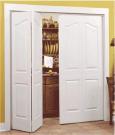 While moving a washer and dryer into the tiny closet area that serves as a laundry room in her condo, a customer just happened to hit the bifold door off of the track. Man, do I hate bifold doors.
While moving a washer and dryer into the tiny closet area that serves as a laundry room in her condo, a customer just happened to hit the bifold door off of the track. Man, do I hate bifold doors.
These are doors that span an opening when closed and when open they fold in half and push to either side of the opening. They are also known as accordion doors. These types of doors always seem to need adjusting.
The hinge side of these doors are secured with a metal bracket to the jamb of the door. The bottom hinge side of the door has a pin that sits in a groove, and the top has a pin that sits in a hole at the top of the opening. The door opens and closes via a spring-loaded guide that rides in a track. When someone hit's the door on accident, it is this part that usually breaks off or comes out of the track (you can get all replacement parts at any home center). This part just pulls out of the door and you can push the new pin right back in.
If the door has been hit, you will likely need to adjust it on the hinge side. This means lifting up the door and moving it slightly on the bottom bracket, or loosening the top guide and slightly moving it. You want the end result to be a smoothly rolling door with uniform gaps around it and the other door it contacts. Here is some more information on adjusting a bifold door.
 I was at a house the other day where a door hinge had been flopping around. The screws holding the hinge to the jamb were stripped out of the wood jamb and were not providing any holding strength. It was an interior door, so there wasn't an issue of security or the door dragging or binding, a common job for this Las Vegas handyman.
I was at a house the other day where a door hinge had been flopping around. The screws holding the hinge to the jamb were stripped out of the wood jamb and were not providing any holding strength. It was an interior door, so there wasn't an issue of security or the door dragging or binding, a common job for this Las Vegas handyman.
There are a couple easy fixes on this. The first is to use a larger screw. The screws provided with hinges are very small with a fairly weak thread profile. This small screw screws into the jamb and holds the door hinge. Use a longer screw to screw past the door jamb and into the frame of the door opening. I would suggest a 2 1/2" screw for this.
The other fix uses a wooden golf tee. Slather a wood golf tee with wood glue and tap it into the old screw hole (you may need to drill out the hole if it is too small). Once the glue dries cut off the golf tee flush with the jamb. Pre-drill a new hole into the end of the golf tee, and this will be your new screw hole.
This is a great fix for cabinet door hinges too.
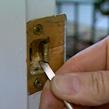 I went to look at a door problem today. The customer was saying that the door wouldn't latch. Sure enough the door swung and closed great, but it just wouldn't latch into the strike plate. The problem was that there was a large gap between the door and the strike jamb that it latches into. Maybe when it was installed, there shims weren't used to square and plumb the frame. The door frame seemed to bow out so that the door's jamb was nailed right to the rough framing without shimming it first. Anyway, through luck or otherwise, the door swung fine, but just didn't latch.
I went to look at a door problem today. The customer was saying that the door wouldn't latch. Sure enough the door swung and closed great, but it just wouldn't latch into the strike plate. The problem was that there was a large gap between the door and the strike jamb that it latches into. Maybe when it was installed, there shims weren't used to square and plumb the frame. The door frame seemed to bow out so that the door's jamb was nailed right to the rough framing without shimming it first. Anyway, through luck or otherwise, the door swung fine, but just didn't latch.
So somehow the trick is to close the gap between the latch edge of the door and the door frame, without removing the trim molding and sinking a lot of time into the repair. You could shim behind the hinges which would close the distance, but this would make it so the hinges wouldn't be flush with the hinge jamb. Not good. I would leave the door alone since it operates well as is.
The other alternative is to remove the trim covering the strike jamb and goose the jamb out towards the door. Since this is an interior door, this would work fine, but you risk cracking the trim while removing it, as well as damaging some paint in the process.
The easiest fix is to remove the strike plate and shim it outwards toward the door, which closes the gap and allows it to latch. Remove the two screws that hold the strike plate to the jamb and you can put a washer (or several washers if the gap is very large) behind the strike plate and then just screw it back in, making sure the screw goes through the center of the washer to hold it in place. You could even use several thicknesses of cardboard in a pinch...a quick repair for a Las Vegas handyman.
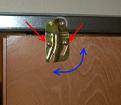 Have you ever had a sliding closet door or a sliding shower door drag so badly that you almost couldn't move it? Well your about 10 minutes away from fixing it. These types of doors hang from a header and have a divider at the bottom that keeps the doors from swinging in and out of the opening.
Have you ever had a sliding closet door or a sliding shower door drag so badly that you almost couldn't move it? Well your about 10 minutes away from fixing it. These types of doors hang from a header and have a divider at the bottom that keeps the doors from swinging in and out of the opening.
The tops of the doors are mounted to metal rollers that sit in the track of the header. Although the rollers sometimes break, the vast majority of problems with these types of doors can be fixed with a door adjustment.
Break out your screwdriver and start snooping at the rollers. Usually, the door needs to be lifted and tightened at the roller. So just loosen the screws that hold the door to the roller assembly and lift the door to the point where it is level and re-tighten the screws. Test it using the one-finger test. If it still gets hung up, adjust it up or down until it rolls smoothly.
Sure, you could go crazy with cleaning and lubricating the wheels, or even replacing them. You will typically find more nastiness with shower rollers due to the addition of water and corrosion, so you will have to replace these far sooner than closet door rollers.
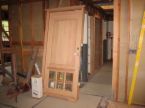 So you know how everyone is trying to save money these days? Well, an out-of-state landlord called us to go look at his property. He was receiving complaints from his tenants that doors he recently had installed weren't working properly. Apparently, he hired two guys that didn't speak English very well, and probably weren't licensed or legal.
So you know how everyone is trying to save money these days? Well, an out-of-state landlord called us to go look at his property. He was receiving complaints from his tenants that doors he recently had installed weren't working properly. Apparently, he hired two guys that didn't speak English very well, and probably weren't licensed or legal.
Wow! One of the doors these guys installed was hung upside down. Instead of the doorknob being at waist level, it was at shoulder level. Then they installed a door on the exterior of the house. For this they used an interior hollow-core door. This type of door, as the name infers, is basically hollow and offers little security. None of the exterior doors they installed had any weatherstripping, and the doorjambs had been cut 2 inches short so that there was a gap that bugs could freely travel through.
Maybe the landlord picked up these guys in a parking lot of a home center, or maybe the "Handyman in Las Vegas" heading in the yellow pages. Your safest bet is to ask around. It's probably best to talk to your friends and neighbors and see who they trust.
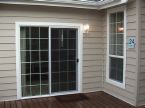 Yesterday we went to repair a customer's sliding glass door. He said he was tired of fighting with it to get it to open. When he called in we told him it we would need to get the correct rollers for the bottom of the door, take the door off, and be done within a couple of hours.
Yesterday we went to repair a customer's sliding glass door. He said he was tired of fighting with it to get it to open. When he called in we told him it we would need to get the correct rollers for the bottom of the door, take the door off, and be done within a couple of hours.
When we got there and looked at it, sure enough you had to throw your shoulder into it to get it to budge. However, the track was filthy. It was covered in dirt with a layer of dog hair mixed in for good measure. Instead of the cost of replacing the rollers on the bottom of the door, we first tried to clean the track. This was pretty disgusting but effective.
Fortunately, the existing sliding glass door rollers were made of metal (some are actually plastic). So after the track was cleaned, we lubricated the rollers. I'm happy to report that the door is as smooth as butter.
Of course, the homeowner watched everything we did and decided to tackle the other door by himself. There is that old saying, "If you give a man a fish he can eat for a day, but if you teach a man to fish he can eat for a lifetime". I'm guessing he will maintain his sliding glass door by himself from now on.
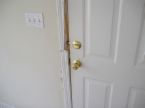 Today we got a new customer. He found us through our print advertising when he looked up someone to repair his kicked in door.
Today we got a new customer. He found us through our print advertising when he looked up someone to repair his kicked in door.
Apparently he was out of town and returned to find that someone had broken into his house. It had all the hallmarks of a break-in. I don't remember the exact number, but a speaker at a meeting I attended said that the vast majority of burglars go right through the front door. That's crazy.
Typically when someone kicks in a door, the deadbolt (or door latch) pulls through the strike jamb (the vertical piece of wood that the door latches into). More damage occurs when the deadbolt chips out the interior door molding. So the strike jamb and the molding need to be replaced. Our new customer expected to come home and relax and instead found an unexpected expense.
However, the customer looked at it as an opportunity. He had wanted to upgrade his front door anyway, and so instead of having us repair the old door, we replaced it with a new door.He was very happy and although he didn't plan on doing it now, he got what he wanted, although a little sooner than he planned.
I think most people would have looked at this as a lemon. This customer, however, made lemonade.
 Carpentry jobs are always fun. Have you ever had a door that closes by itself, and it isn't supposed to? Or maybe a door that doesn't latch correctly? These are actually pretty simple to fix.
Carpentry jobs are always fun. Have you ever had a door that closes by itself, and it isn't supposed to? Or maybe a door that doesn't latch correctly? These are actually pretty simple to fix.
Let's take the first problem. This door closes by itself because it is not plumb.
You could spend hours trying to get it plumb, putting shims behind hinges and chiseling wood here and there. Or you could decide to do the quick fix: bend the door's hinge pin. Now, you're not going to bend it by much, mind you, just enough to cause a little friction in the hinge. Pop the bottom hinge pin out by tapping it with a stubby screwdriver and a hammer. Set the hinge pin on a hard surface (not the kitchen table) like the sidewalk. Tap it gently with a hammer in the center of the pin so that it puts a slight crook in the pin.
Reinstall the pin by tapping it into the hinge with a hammer. If your door is large and heavy, you may need to repeat this with the next hinge pin to gain some uniform friction. Problem solved.
The other door that doesn't latch correctly is easy to fix, too, but not as easy as smacking a hinge pin with a hammer. This problem stems from the strike plate and the door latch not being aligned. The strike plate is the flat piece of metal on the doorjamb with the hole in it that accepts the door latch (the part that sticks out of the side of the door).
The door latch may be too high or low to enter the hole in the strike plate. The strike plate may be so far in that you practically have to throw your shoulder into the door to get it to latch. Assuming the problem isn't due to a warped door, you really have only two options: move the strike plate or the door latch.
If the alignment problem is due to a height difference between the strike plate and latch, try to move the latch first. Cut out a piece of cardboard and shim it behind one of the door hinges. If the latch is too high, place the shim between the doorjamb and the top hinge. If the latch is too low, shim between the doorjamb and the bottom hinge.
The other option is to unscrew the two screws that hold the strike plate and raise or lower it to meet the latch. The only downfall with this is that you will need to chisel out the wood in the strike jamb so that the plate sits flush with the jamb. This isn't hard, but it will leave a noticeable mortise. This, however, can be filled in with wood putty and painted.
Align the strike plate with the latch and make trace marks with a pencil on the jamb. Chisel out the wood to the depth of the plate. Use short, light taps instead of one big one as you will tear out more wood than you expect.
Fill in the old screw holes since you will likely be moving the strike plate a small amount (the screws will tend to wander into the old holes and make alignment nearly impossible). Slather wood golf tees with wood glue, stuff them into the holes and saw them off flush with the surrounding wood.
Hold the strike plate back up to the jamb and mark the location of the holes. Predrill small pilot holes and then screw the strike plate to the jamb. Your door should close and latch effortlessly.